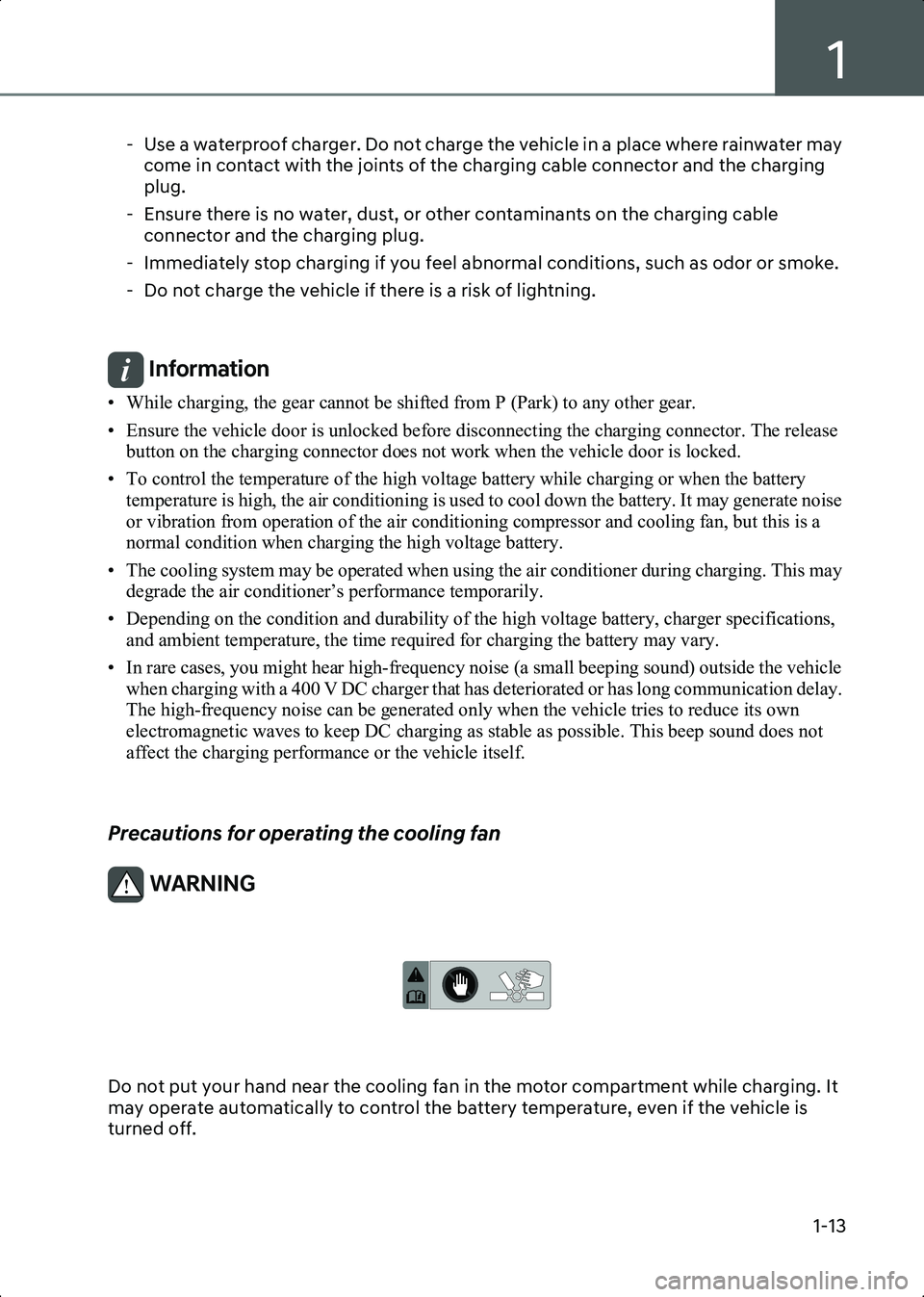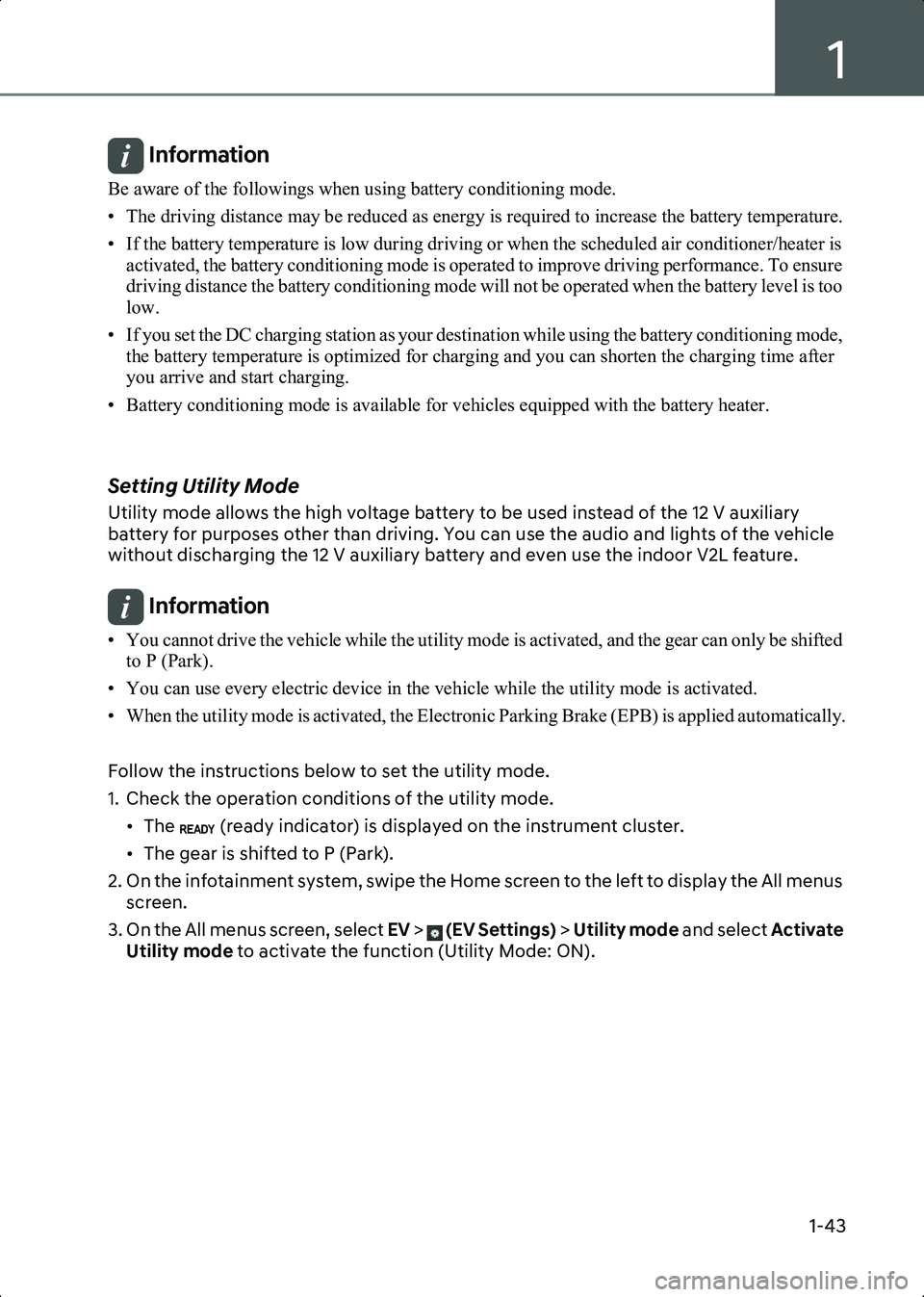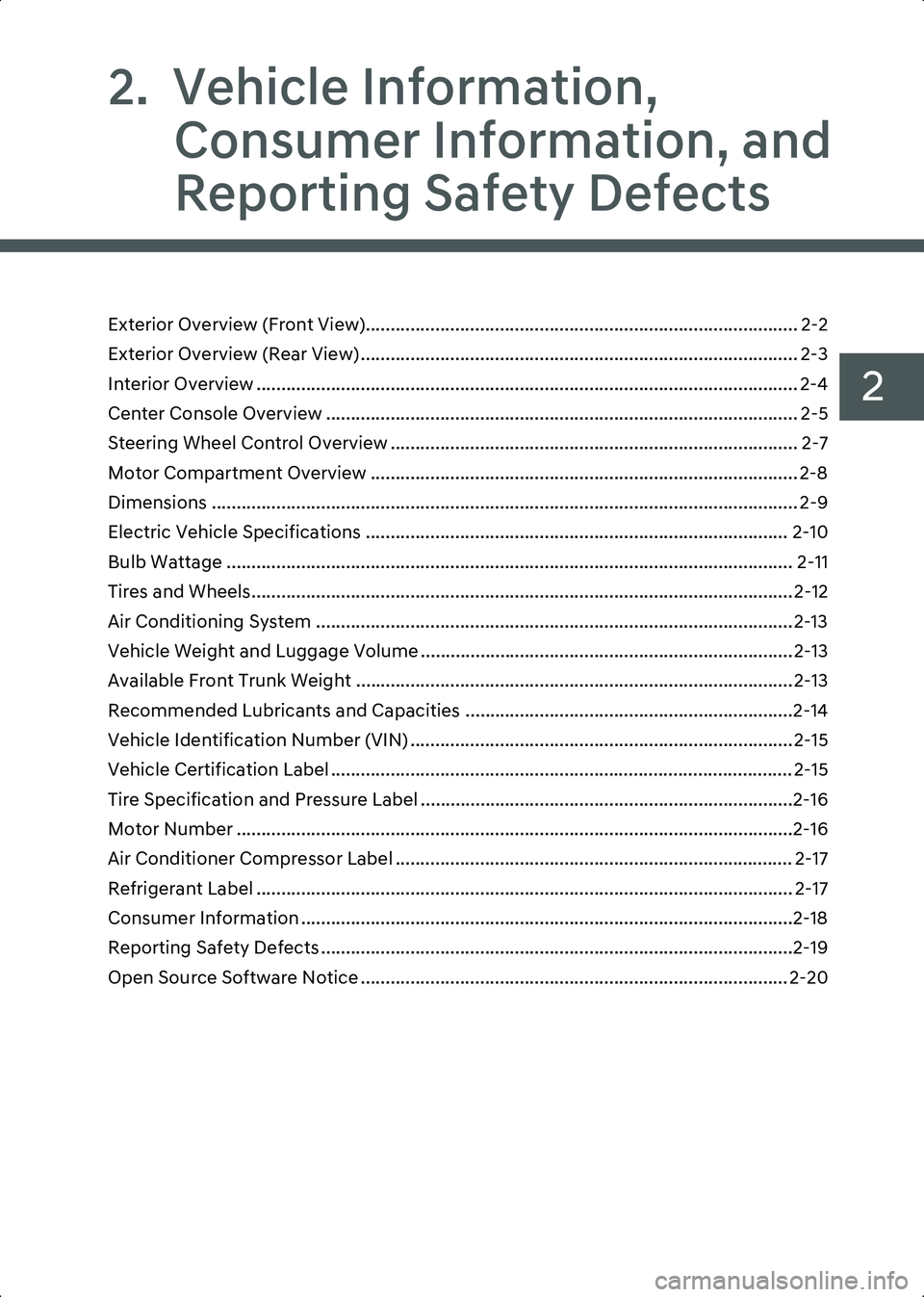2023 HYUNDAI IONIQ 6 air conditioning
[x] Cancel search: air conditioningPage 19 of 582

1
1-13
- Use a waterproof charger. Do not charge the vehicle in a place where rainwater may come in contact with the joints of the charging cable connector and the charging
plug.
- Ensure there is no water, dust, or other contaminants on the charging cable connector and the charging plug.
- Immediately stop charging if you feel abnormal conditions, such as odor or smoke.
- Do not charge the vehicle if there is a risk of lightning.
Information • While charging, the gear cannot be shifted from P (Park) to any other gear.
• Ensure the vehicle door is unlocked before disconnecting the charging connector. The release button on the charging connector does not work when the vehicle door is locked.
• To control the temperature of the high voltage battery while charging or when the battery temperature is high, the air conditioning is used to cool down the battery. It may generate noise
or vibration from operation of the air conditioning compressor and cooling fan, but this is a
normal condition when charging the high voltage battery.
• The cooling system may be operated when using the air conditioner during charging. This may degrade the air conditioner’s performance temporarily.
• Depending on the condition and durability of the high voltage battery, charger specifications, and ambient temperature, the time required for charging the battery may vary.
• In rare cases, you might hear high-frequency noise (a small beeping sound) outside the vehicle when charging with a 400 V DC charger that has deteriorated or has long communication delay.
The high-frequency noise can be generated only when the vehicle tries to reduce its own
electromagnetic waves to keep DC charging as stable as possible. This beep sound does not
affect the charging performance or the vehicle itself.
Precautions for operating the cooling fan
WARNING
WL_MotorRoomHotCaution
Do not put your hand near the cooling fan in the motor compartment while charging. It
may operate automatically to control the battery temperature, even if the vehicle is
turned off.
Hyundai_CE_en_US.book Page 13
Page 46 of 582

Introduction/Getting Started with Your Electric Vehicle
1-40
Setting a scheduled climate
Follow the instructions below to set the scheduled climate control temperature.
1. On the infotainment system, swipe the Home screen to the left to display the All menus screen.
2. On the All menus screen, select EV > Scheduled Charging and Climate > Scheduled
Charging .
3. Set the desired temperature. • The air conditioning system is activated at the departure time.
• For more information about setting the departure time, refer to the “Setting the Next Departure Time” section in this chapter.
B0001902
Setting a Battery Discharging Limit When Using Vehicle to Load
(V2L)
Setting battery discharging limit (%) can prevent the battery from discharging when
operating home appliances or electronic devices using the high voltage battery.
• For more information about V2L function, refer to the “Setting the Next Departure Time” section in this chapter.
Information V2L is the system provides AC power using the high voltage battery for driving to operate several
electronic devices. You can operate home appliances and electronic devices, or charge another
electric vehicle in emergency using the charged electricity from the vehicle’s battery while
camping or doing other outdoor activities.
1. On the infotainment system, swipe the Home screen to the left to display the All menus screen.
2. On the All menus screen, select EV > Electricity Use .
3. Set the desired battery discharging limit (%). • The battery discharging limit can only be set below the current high voltage battery level.
• When the high voltage battery level reaches the set battery discharging limit, V2L function automatically cuts off electrical supply.
10�×
Hyundai_CE_en_US.book Page 40
Page 49 of 582

1
1-43
Information Be aware of the followings when using battery conditioning mode.
• The driving distance may be reduced as energy is required to increase the battery temperature.
• If the battery temperature is low during driving or when the scheduled air conditioner/heater is activated, the battery conditioning mode is operated to improve driving performance. To ensure
driving distance the battery conditioning mode will not be operated when the battery level is too
low.
• If you set the DC charging station as your destination while using the battery conditioning mode, the battery temperature is optimized for charging and you can shorten the charging time after
you arrive and start charging.
• Battery conditioning mode is available for vehicles equipped with the battery heater.
Setting Utility Mode
Utility mode allows the high voltage battery to be used instead of the 12 V auxiliary
battery for purposes other than driving. You can use the audio and lights of the vehicle
without discharging the 12 V auxiliary battery and even use the indoor V2L feature.
Information • You cannot drive the vehicle while the utility mode is activated, and the gear can only be shifted to P (Park).
• You can use every electric device in the vehicle while the utility mode is activated.
• When the utility mode is activated, the Electronic Parking Brake (EPB) is applied automatically.
Follow the instructions below to set the utility mode.
1. Check the operation conditions of the utility mode. • The (ready indicator) is displayed on the instrument cluster.
• The gear is shifted to P (Park).
2. On the infotainment system, swipe the Home screen to the left to display the All menus screen.
3. On the All menus screen, select EV > (EV Settings) > Utility mode and select Activate
Utility mode to activate the function (Utility Mode: ON).
Hyundai_CE_en_US.book Page 43
Page 59 of 582

1
1-53
Driving Your Electric Vehicle
Check how to use the devices inside the vehicle that you must know for driving, such as
starting, braking, and shifting the electric vehicle.
Starting and Stopping the Vehicle
Follow the instructions below to start or stop the vehicle.
CAUTION • Always fasten the seat belt before starting the vehicle for safety.
• Check if the EBP is applied before starting the vehicle.
Starting the vehicle
1. Holding the smart key, sit in the driver’s seat.
2. Press the Start/Stop button while pressing the brake pedal.• On the instrument cluster, (ready indicator) is displayed.
Information While the (ready indicator) is displayed, press the brake pedal, shift to D (Drive) or R
(Reverse), and release the EBP and the brake pedal to start moving the vehicle forward or
backward. You can start driving by pressing the accelerator pedal slowly and decelerate or stop by
pressing the brake pedal.
Stopping the vehicle
1. Stop the vehicle completely by pressing the brake pedal.
2. Apply the EPB while pressing the brake pedal, and press the gear’s P button to shift to P (Park).
3. Press the Start/Stop button. • The (ready indicator) on the instrument cluster turns off.
Information There are other Start/Stop button positions besides the ON/OFF. Use it appropriately paying
attention to the discharging of the 12 V battery.
•ACC : The 12 V battery power is turned on, allowing some devices, such as infotainment system
and air conditioning system to operate. Press the Start/Stop button when it is in the OFF position
to turn on ACC.
• ON : The 12 V battery power is turned on, allowing to check the instrument cluster and use all
the electric devices inside the vehicle. Press the Start/Stop button when it is in the ACC position
to turn it ON.
Hyundai_CE_en_US.book Page 53
Page 65 of 582

1
1-59
Checking the warning lights
Check the cause of the warning lights referring to the table below and take appropriate
measures.
Warning LightCauseMeasure
Service warning light This warning light illuminates:
• When there is a problem with
related parts of the electric
vehicle control system, such
as sensors, etc.
• When an actuator, electric compressor for air
conditioning, etc.
malfunctions. In a normal condition, it
illuminates for about 3 seconds
when the Start/Stop button is in
the ON position and then goes
off.
• When the warning light
illuminates while driving, or
does not go off after starting
the vehicle, have your vehicle
inspected by an authorized
HYUNDAI dealer.
Power down indicator light This warning light illuminates:
• When the high voltage
battery level is too low or
voltage is decreasing.
(Output limit occurs when the
charge level is insufficient.)
• When the temperature of the high voltage battery is too
high or too low.
• When the driving system temperature is overheated
and requires protection. If it illuminates alone, it is not
failure.
• If both Power down indicator
light and Service warning
light illuminate at the same
time, have the vehicle
inspected by an authorized
HYUNDAI dealer.
• When the indicator is illuminating, immediately
charge the vehicle. The
driving speed may be limited
and the vehicle may not
properly drive uphill.
High voltage battery level warning light This warning light illuminates
when the high voltage battery
level is low. Immediately charge the
vehicle. The vehicle can drive
an additional 18-31 mi. (30-50
km).
• The actual distance to empty
depends on the driving
conditions.
Regenerative brake warning light This warning light illuminates
when the regenerative brake
does not operate and the brake
does not perform well due to
the malfunction of the brake
system. Drive safely and have your
vehicle inspected by an
authorized HYUNDAI dealer.
• The operation of the brake
pedal may feel deeper than
normal or the braking
distance may increase.
Hyundai_CE_en_US.book Page 59
Page 75 of 582

2
2. Vehicle Information, Consumer Information, and
Reporting Safety Defects
Exterior Overview (Front View)....................................................................................... 2-2
Exterior Overview (Rear View) ........................................................................................ 2-3
Interior Overview ............................................................................................................. 2-4
Center Console Overview ............................................................................................... 2-5
Steering Wheel Control Overview .................................................................................. 2-7
Motor Compartment Overview ...................................................................................... 2-8
Dimensions ...................................................................................................................... 2-9
Electric Vehicle Specifications ..................................................................................... 2-10
Bulb Wattage .................................................................................................................. 2-11
Tires and Wheels............................................................................................................. 2-12
Air Conditioning System ................................................................................................2-13
Vehicle Weight and Luggage Volume ...........................................................................2-13
Available Front Trunk Weight ........................................................................................2-13
Recommended Lubricants and Capacities ..................................................................2-14
Vehicle Identification Number (VIN) ............................................................................. 2-15
Vehicle Certification Label ............................................................................................. 2-15
Tire Specification and Pressure Label ...........................................................................2-16
Motor Number ................................................................................................................2-16
Air Conditioner Compressor Label ................................................................................ 2-17
Refrigerant Label ............................................................................................................ 2-17
Consumer Information ...................................................................................................2-18
Reporting Safety Defects ...............................................................................................2-19
Open Source Software Notice ...................................................................................... 2-20
Hyundai_CE_en_US.book Page 1
Page 87 of 582

2
2-13
Air Conditioning System
Contact an authorized HYUNDAI dealer for more information.
Vehicle Weight and Luggage Volume
Available Front Trunk Weight
ItemWeight of VolumeClassification
Refrigerant Heat pump
32±0.9 oz. (900±25 g)
R-1234yf
Without heat
pump 25±0.9 oz. (700±25 g)
Compressor lubricant Heat pump
6.11±0.35 oz. (190±10 g)
POE
Without heat
pump 5.29±0.35 oz. (150±10 g)
Gross Vehicle WeightLuggage VolumeStandard TypeExtended Type
2WD: 4,894 lbs. (2220 kg) 2WD: 5,313 lbs. (2410 kg)
AWD: 5,556 lbs. (2520 kg) 14.2 cu.ft (401 ℓ)
2WD / AWD
25 lbs. (10 kg)
Hyundai_CE_en_US.book Page 13
Page 112 of 582

Seats & Safety System
3-18
if equipped
Front air ventilation seats
Infotainment system
ONE1031085L
While the vehicle is running, touch
Heating/Ventilation icon in the
infotainment system.
Climate control panel
B3000602
Press in the front climate control
panel.
ONE1031080L
To activate air ventilation of each front
seats, touch icon on the infotainment
system. Adjust the airflow by pressing
either or icons.• If the air ventilation seat is position to
'HIGH', fan speed increases depending
on the vehicle speed and driving time.
• Use the air ventilation seat with the air conditioning on for more effective
ventilation.
• It may take 3-5 minutes after switch operation to feel the temperature
change.
• Auto. Controls That Use Climate Control Settings (for driver’s seat)
The air ventilation seat automatically
controls the seat temperature
depending on the ambient temperature
when the vehicle is on ( indicator
on).
To use this function, it can be enabled
from the Settings menu in the
infotainment system. Select: Setup >
Vehicle > Seat > Heated/Ventilated
Features > Auto. Controls That Use
Climate Control Settings > Seat
Warmer/Ventilation
• The air ventilation seats defaults to the OFF position whenever the Start/Stop
button is pressed to the ON position.
However, if the Auto. Controls That Use
Climate Control Settings function is on,
the driver’s air ventilation seat turns on
and off depending on the ambient
temperature.
Information The infotainment system may change after
software updates. For more information, refer
to the user's manual provided in the
infotainment system and the quick reference
guide.
Hyundai_CE_en_US.book Page 18